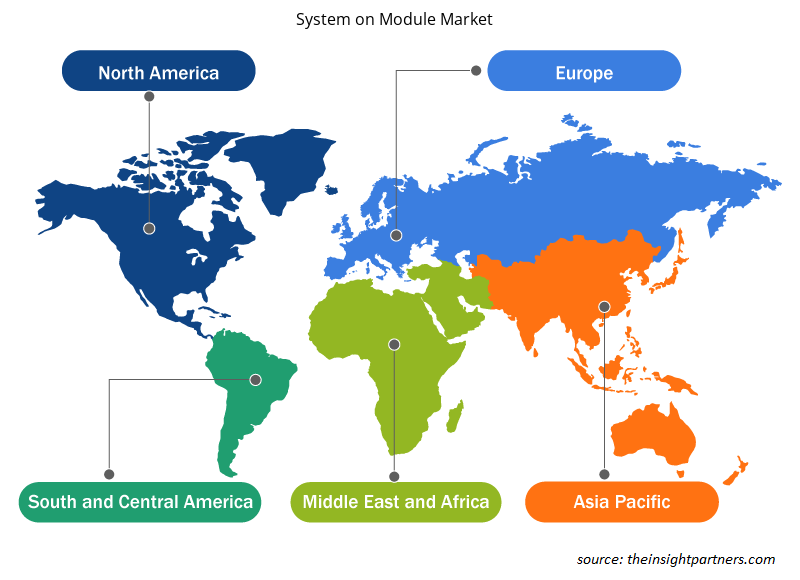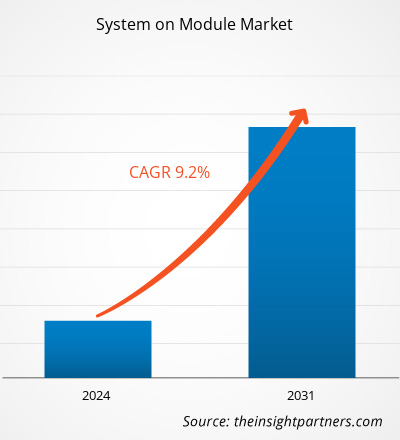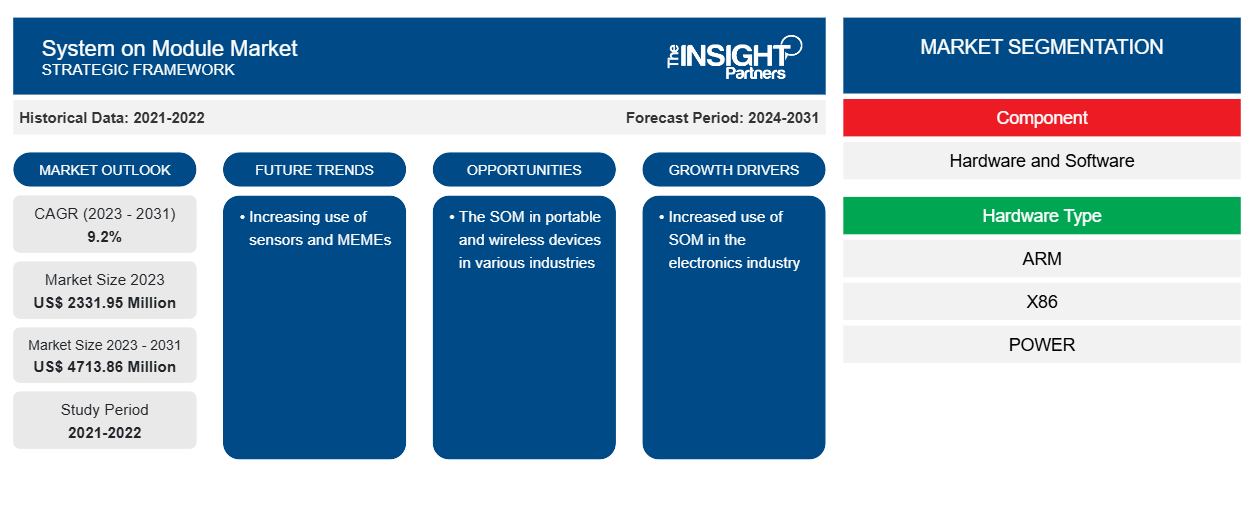Si prevede che la dimensione del mercato dei moduli di sistema raggiungerà i 4713,86 milioni di dollari entro il 2031, rispetto ai 2331,95 milioni di dollari del 2023. Si prevede che il mercato registrerà un CAGR del 9,2% nel periodo 2023-2031. È probabile che l'uso crescente di sensori e MEME rimanga una tendenza chiave nel mercato.
Analisi di mercato del sistema su modulo
Il lockdown mondiale per ridurre la trasmissione del virus ha interrotto in modo significativo le attività della supply chain e la capacità produttiva di diversi produttori, in particolare i proprietari di piccole e medie imprese. L'industria dei semiconduttori ha contribuito in modo significativo alla domanda di componenti elettronici da parte del settore industriale e degli utenti finali. Il modello di fatturato per la microelettronica è diminuito a causa della mancanza di produzione di massa durante il periodo di lockdown. L'industria dei semiconduttori ha gradualmente riguadagnato quote di mercato poiché gli stabilimenti di produzione hanno riavviato le loro operazioni adottando misure di distanziamento sociale. Inoltre, le strategie di lavoro da casa e di monitoraggio remoto hanno anche aumentato le vendite di prodotti elettronici avanzati per una migliore connettività. L'importanza dell'IT e del settore delle telecomunicazioni è stata evidenziata a fini comunicativi, che hanno riconosciuto l'evoluzione del settore con nuove tecnologie come la tecnologia di confezionamento compatibile con Wi-Fi ad alta velocità.
Panoramica del mercato dei sistemi su moduli
Un System-on-Module (SOM) presenta i componenti principali di un sistema di elaborazione incorporato, come blocchi di memoria, interfacce di comunicazione e core di elaborazione, su un singolo circuito stampato (PCB) pronto per la produzione. Questo approccio modulare rende un SOM adatto per l'incorporamento in sistemi finali, dai robot alle telecamere di sicurezza . Il concetto di System-on-Module si è evoluto dai blade server. Questi server sottili sono stati creati per risparmiare spazio di archiviazione e ridurre il consumo energetico. L'architettura dei SOM influenza la mentalità di progettazione snella alla base dei blade server. Includono solo i componenti necessari per la loro funzione prevista nel pacchetto più piccolo possibile e sono sufficientemente flessibili da adattarsi a un'ampia gamma di applicazioni.
Personalizza questo report in base alle tue esigenze
Riceverai la personalizzazione gratuita di qualsiasi report, comprese parti di questo report, o analisi a livello nazionale, pacchetto dati Excel, oltre a usufruire di grandi offerte e sconti per start-up e università
-
Scopri le principali tendenze di mercato in questo rapporto.Questo campione GRATUITO includerà analisi di dati che spaziano dalle tendenze di mercato alle stime e alle previsioni.
Driver e opportunità del mercato dei sistemi su moduli
Maggiore utilizzo di SOM nell'industria elettronica
In quanto componenti core flessibili, i SOM consentono uno sviluppo rapido in varie applicazioni tecnologiche, dall'elettronica di consumo all'automazione industriale, rendendoli essenziali nella progettazione di prodotti moderni. Nell'ambiente in rapida evoluzione della progettazione di prodotti elettronici, la metodologia System on Module (SoM) è emersa come una fonte chiave di trasformazione. Grazie alle sue dimensioni compatte, alle elevate prestazioni e alla convenienza, SoM sta diventando una scelta popolare tra progettisti e ingegneri. Pertanto, il crescente utilizzo di SOM nel settore dell'elettronica sta guidando la crescita del mercato.
Il SOM nei dispositivi portatili e wireless in vari settori
I SoM sono utilizzati in dispositivi medici portatili in cui affidabilità e compattezza sono fondamentali. Ad esempio, un SoM potrebbe essere integrato in un dispositivo a ultrasuoni portatile , fornendo la potenza di elaborazione e la connettività necessarie in un fattore di forma compatto. I SoM sono impiegati in sistemi avanzati di assistenza alla guida (ADAS) in cui forniscono capacità di elaborazione ad alte prestazioni necessarie per l'elaborazione in tempo reale dei dati dei sensori. In contesti industriali, i SoM sono utilizzati in controllori logici programmabili (PLC) e interfacce uomo-macchina (HMI), offrendo soluzioni robuste e scalabili per attività di automazione complesse.
Analisi della segmentazione del rapporto di mercato del sistema su modulo
I segmenti chiave che hanno contribuito alla derivazione dell'analisi di mercato del sistema su modulo sono i componenti, il tipo di hardware e l'applicazione.
- In base al componente, il sistema sul mercato dei moduli è diviso in hardware e software. Il segmento delle schede sonda standard ha detenuto una quota di mercato maggiore nel 2023.
- In base al tipo di hardware, il mercato è segmentato in ARM, X86, POWER, FPGA, GPU, DSP e RISC-V. Il segmento surface-mounted ha detenuto una quota di mercato maggiore nel 2023.
- In base all'applicazione, il mercato è segmentato in automazione industriale, intrattenimento, medicina, trasporti, test e misurazione, applicazioni video e altri.
Analisi della quota di mercato del sistema su modulo per area geografica
L'ambito geografico del sistema nel rapporto di mercato dei moduli è suddiviso principalmente in cinque regioni: Nord America, Asia Pacifico, Europa, Medio Oriente e Africa, e Sud e Centro America.
L'APAC domina il mercato dei sistemi su modulo. Molti dei paesi dell'APAC sono caratterizzati dalla quantità di dispositivi elettronici richiesti per componenti automobilistici, dispositivi di telecomunicazione, elettronica di consumo e altri tipi di macchinari industriali. Il crescente numero di aziende manifatturiere di elettronica in Cina e India, dovuto alla forte accessibilità di risorse umane qualificate, sta guidando il mercato dei sistemi su modulo.
Approfondimenti regionali sul mercato dei sistemi su moduli
Le tendenze regionali e i fattori che influenzano il mercato System on Module durante il periodo di previsione sono stati ampiamente spiegati dagli analisti di Insight Partners. Questa sezione discute anche i segmenti e la geografia del mercato System on Module in Nord America, Europa, Asia Pacifico, Medio Oriente e Africa, e America Centrale e Meridionale.

- Ottieni i dati specifici regionali per il mercato del sistema sul modulo
Ambito del rapporto di mercato del sistema su modulo
| Attributo del report | Dettagli |
|---|---|
| Dimensioni del mercato nel 2023 | 2331,95 milioni di dollari USA |
| Dimensioni del mercato entro il 2031 | 4713,86 milioni di dollari USA |
| CAGR globale (2023-2031) | 9,2% |
| Dati storici | 2021-2022 |
| Periodo di previsione | 2024-2031 |
| Segmenti coperti |
Per componente
|
| Regioni e Paesi coperti |
America del Nord
|
| Leader di mercato e profili aziendali chiave |
|
Sistema su modulo Densità dei giocatori del mercato: comprendere il suo impatto sulle dinamiche aziendali
Il mercato del System on Module Market sta crescendo rapidamente, spinto dalla crescente domanda degli utenti finali dovuta a fattori quali l'evoluzione delle preferenze dei consumatori, i progressi tecnologici e una maggiore consapevolezza dei vantaggi del prodotto. Con l'aumento della domanda, le aziende stanno ampliando le loro offerte, innovando per soddisfare le esigenze dei consumatori e capitalizzando sulle tendenze emergenti, il che alimenta ulteriormente la crescita del mercato.
La densità degli operatori di mercato si riferisce alla distribuzione di aziende o società che operano in un particolare mercato o settore. Indica quanti concorrenti (operatori di mercato) sono presenti in un dato spazio di mercato in relazione alle sue dimensioni o al valore di mercato totale.
Le principali aziende che operano nel mercato dei sistemi su moduli sono:
- Tecnologia dei microchip
- Inc.
- Società anonima Advantech Co. Ltd.
- SoMLabs
- Azienda
- Collega Tech Inc.
Disclaimer : le aziende elencate sopra non sono classificate secondo un ordine particolare.

- Ottieni la panoramica dei principali attori del mercato System on Module
Notizie di mercato e sviluppi recenti del sistema su modulo
Il sistema sul mercato dei moduli viene valutato raccogliendo dati qualitativi e quantitativi dopo la ricerca primaria e secondaria, che include importanti pubblicazioni aziendali, dati di associazioni e database. Di seguito sono elencati alcuni degli sviluppi nel sistema sul mercato dei moduli:
- Toradex, fornitore leader di soluzioni per sistemi embedded, ha lanciato la sua nuova famiglia di sistemi su moduli (SoM) compatibili con i pin e scalabili: Aquila. (Fonte: Toradex, comunicato stampa, aprile 2024)
- NetBurner ha annunciato il lancio della sua ultima soluzione, il sistema su modulo (SOM) SOMRT1061. Con prestazioni in un piccolo formato da 25,4 mm, è ideale per l'uso come processore di sistema principale, sottoprocessore di rete o persino server Serial to Ethernet crittografato. (Fonte: NetBurner, comunicato stampa, maggio 2024)
Copertura e risultati del rapporto di mercato del sistema su modulo
Il rapporto "Dimensioni e previsioni del mercato dei sistemi su moduli (2021-2031)" fornisce un'analisi dettagliata del mercato che copre le seguenti aree:
- Dimensioni e previsioni del mercato del sistema su modulo a livello globale, regionale e nazionale per tutti i segmenti di mercato chiave coperti dall'ambito
- Tendenze del mercato del sistema sui moduli e dinamiche di mercato come driver, vincoli e opportunità chiave
- Analisi dettagliata delle cinque forze PEST/Porter e SWOT
- analisi di mercato del sistema su modulo che copre le principali tendenze del mercato, il quadro globale e regionale, i principali attori, le normative e i recenti sviluppi del mercato
- Analisi del panorama industriale e della concorrenza che copre la concentrazione del mercato, l'analisi della mappa di calore, i principali attori e gli sviluppi recenti per il sistema sul mercato dei moduli
- Profili aziendali dettagliati
- Analisi storica (2 anni), anno base, previsione (7 anni) con CAGR
- Analisi PEST e SWOT
- Valore/volume delle dimensioni del mercato - Globale, Regionale, Nazionale
- Industria e panorama competitivo
- Set di dati Excel
Report recenti
Testimonianze
Motivo dell'acquisto
- Processo decisionale informato
- Comprensione delle dinamiche di mercato
- Analisi competitiva
- Analisi dei clienti
- Previsioni di mercato
- Mitigazione del rischio
- Pianificazione strategica
- Giustificazione degli investimenti
- Identificazione dei mercati emergenti
- Miglioramento delle strategie di marketing
- Aumento dell'efficienza operativa
- Allineamento alle tendenze normative























 Ottieni un campione gratuito per - Sistema sul mercato dei moduli
Ottieni un campione gratuito per - Sistema sul mercato dei moduli